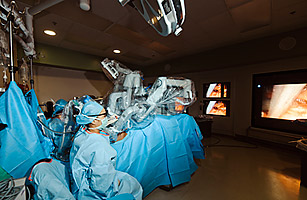
(3 of 4)
Excellence and innovation, the jewels of America's battered health care crown, flow from this freedom to be creative. The rub comes when you try to subject that creativity to a rigorous cost-benefit analysis. Which brings us back to the robot.
Ten years into the revolution, robotic surgery is undeniably popular, but whether it is worth its price tag is a matter of hot debate. A da Vinci system costs more than $1 million, and roughly $1,500 worth of parts must be replaced after every procedure. The robot also entails significant additional training for surgeons. Authorities on prostate cancer, for example, generally agree that a typical surgeon will need to perform as many as 50 prostatectomies with the robot before achieving real proficiency.
But such questions aren't slowing the revolution. Robotics are gaining ground on traditional techniques for most abdominal surgeries. The urologists who started with prostate surgery have expanded to kidney and bladder procedures. The gynecologists who in the 1980s and 1990s were early adopters of laparoscopy are now, in more and more cases, using robots to assist with hysterectomies, fibroid surgery, treatments for infertility and more. Innovation begets innovation.
Cardiac surgeons are using the machines to repair mitral valves and perform bypass surgery without having to reach for a rib spreader. Robots make it possible to extract a cancerous thyroid gland through the patient's armpit, leaving the throat unscarred. For certain other diseases, like tumors of the larynx, tonsil and tongue, surgeons at the University of Pennsylvania have developed robotic procedures that enter the throat through the patient's mouth. This has made brutally invasive surgeries — involving large incisions, pulled teeth and broken jaws — far less punishing, if hardly pain-free.
The success of the da Vinci robot — and the steep rise in the manufacturer's bottom line — is spurring other companies to design robots for even smaller applications. A Florida company, Mako Surgical, recently introduced a robotic arm to assist in surgery on arthritic knees. And yet as the technology goes racing ahead into nearly every part of the body, the medical community has not been able to decide whether even Menon's decade-old surgery is worth the extra dollars. The answer to that question seems to change depending on whom you ask.
"My skills are in innovation and scholarship, not marketing," Menon says candidly, and so he characteristically begins his answer by acknowledging that robots, thus far, have not improved his ability to cure prostate cancer. "It doesn't matter what tools you use to cut, the cure rate will be the same."
But the robots do have real benefits. "Any time you can do the same surgery in a minimally invasive way, you should," says Menon, "and the robot facilitates that. It's clearly better in terms of blood loss. It's not unusual in an open procedure for the patient to lose a liter of blood. Our patients lose more blood to preoperative testing than they do during surgery." Furthermore, the vast majority of the robot's patients are discharged from the hospital within 24 hours, and only 5% to 10% of them experience complications, compared with up to 30% of open-surgery patients. Robotic-surgery patients begin to regain urinary control and, perhaps, sexual potency more quickly than open-surgery patients, says Menon. But after the first month or so following surgery, patients with longer scars begin to catch up, and the recovery paths of robotic and conventional patients tend to converge.
Some doctors, more skilled at spin, make more lavish claims for the robotic procedure, based on self-reported data. A man who believes everything he reads on the Internet might conclude that robots have rendered prostate cancer a mere nuisance, easily cured, with scant side effects. Many robotic surgeons have begun to worry about a backlash from this aggressive overselling. A recent survey found that prostate-cancer patients who chose robotic-assisted surgery were more likely to report disappointment with their treatment than patients who opted for open surgery — which was odd, because their results were not worse. The obvious conclusion: their expectations had been raised beyond the robot's ability to deliver, especially in one respect. "Regaining normal sexual function is still the issue," says Menon.